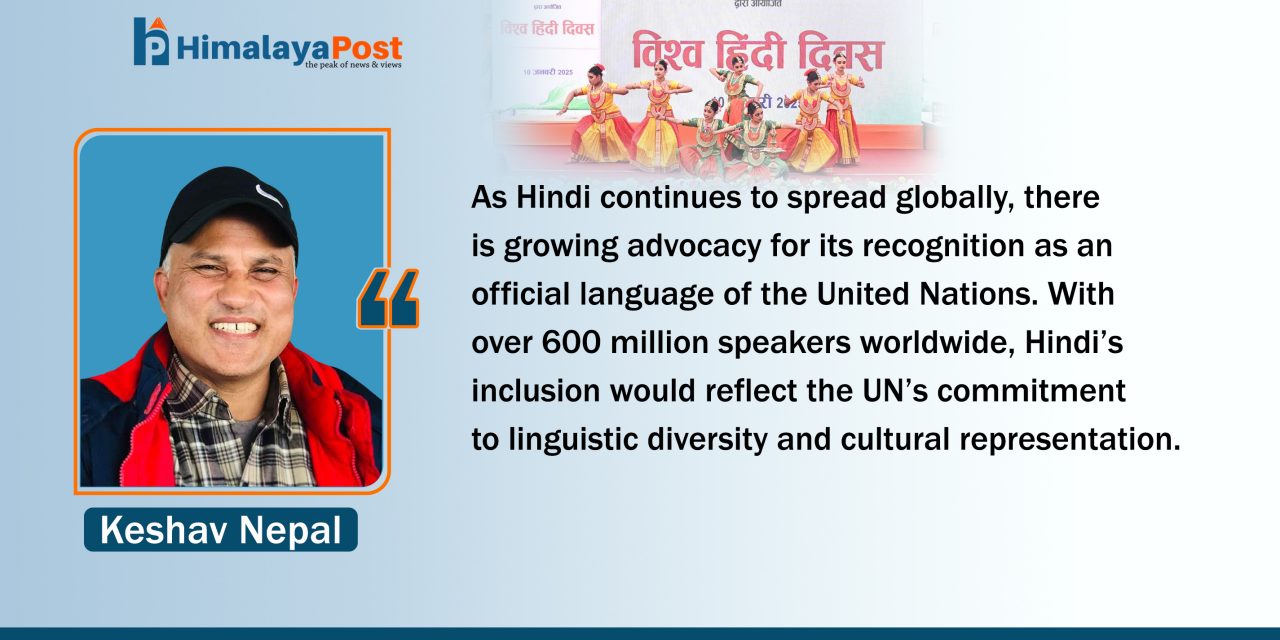– Keshav Nepal
Today, on World Hindi Day (Vishwa Hindi Divas), we celebrate the global journey of Hindi, one of the most widely spoken languages in the world. Celebrated annually on January 10th, World Hindi Day honors the historical significance and growing influence of Hindi worldwide. The theme for World Hindi Day 2025 is “A Global Voice of Unity and Cultural Pride,” which aims to encourage linguistic and cultural exchange through the Hindi language. Originating from the Indo-Aryan branch of the Indo-European language family, Hindi has evolved over centuries, crossing geographical and linguistic barriers. Its expansion from the Indian subcontinent to regions like Indonesia, the Gulf, and beyond has established Hindi as a global lingua franca.
The Origin of Hindi
Hindi’s origins trace back to the Indo-Aryan languages, which evolved from Sanskrit, the ancient language of India. Over time, Hindi developed through several stages. Between the 7th and 9th centuries CE, it emerged from Apabhramsa of Sanskrit and Prakrit languages. The early form of Hindi, known as Khari Boli, began to take shape in the Delhi region and other parts of northern India.
By the 12th century, during the medieval period, Hindi flourished under the influence of regional languages and foreign elements from Persian, Arabic, and Turkic languages, brought about by interactions with the invasive empires. The Bhakti movement and poets like Kabir and Tulsidas played a crucial role in popularizing Hindi literature and poetry, further cementing the language’s cultural significance.
The 19th century saw the standardization of Hindi as a distinct language with the introduction of the Devanagari script. Following India’s independence in 1947, Hindi was officially adopted as the national language, solidifying its position as a prominent language of India.
Expansion of Hindi in the Indian Subcontinent
The spread of Hindi beyond its regional boundaries began in the 19th and 20th centuries, driven by migration, trade, and cultural exchanges. Hindi-speaking communities moved to neighboring regions, where it became a bridge language for various communities, fostering communication and cultural interaction.
Cultural influences also played a major role in spreading Hindi. Hindi literature, music, and cinema contributed significantly to the language’s popularity across the subcontinent. Hindi films, with their engaging narratives and melodious songs, crossed linguistic barriers and reached diverse audiences.
Hindi’s influence also spread to Southeast Asia, particularly in countries like Indonesia, Malaysia, and others, where Indian kings ruled until the 11th century, and Indian traders and laborers had settled over time. In these regions, Hindi blended with local languages, enriching the region’s linguistic diversity.
Hindi as a Lingua Franca in the Gulf Region and Beyond
In the Gulf region, with its large Indian expatriate population, Hindi has emerged as a lingua franca connecting people across different cultural and linguistic backgrounds. Bollywood films and music, widely popular in the Gulf, serve as a unifying force, helping Hindi bridge gaps between Indian expatriates and local populations.
Hindi’s influence has also spread to Europe, Africa, and other parts of the world, where it is increasingly taught in language institutes and universities. The global Indian diaspora has played a key role in spreading the language, creating a vast network of Hindi speakers.
In the Arab world, Hindi’s popularity is evident, with many locals learning the language to connect with the Indian community and enjoy Bollywood films. This exchange has led to the emergence of Hindi-speaking communities in countries such as Saudi Arabia, UAE, and Qatar.
The Case for Hindi as an Official Language of the UN
As Hindi continues to spread globally, there is growing advocacy for its recognition as an official language of the United Nations. With over 600 million speakers worldwide, Hindi’s inclusion would reflect the UN’s commitment to linguistic diversity and cultural representation. Recognizing Hindi as an official language would foster greater cultural diplomacy and facilitate cross-cultural dialogue, particularly between South Asia and the Gulf region.
Similarities Between Nepali and Hindi
Hindi shares strong linguistic ties with Nepali, as both languages belong to the Indo-Aryan branch of the Indo-European family. They share common grammatical structures and vocabulary, making it easier for speakers of one language to understand the other.
In Nepal, various dialects such as Maithili, Bhojpuri, and Awadhi also draw from Hindi, serving as a bridge language for diverse communities. These dialects reflect Nepal’s rich cultural heritage while maintaining connections to Hindi.
The Impact of Hindi Cinema and Music
Hindi cinema, particularly Bollywood, has played a vital role in spreading Hindi worldwide. Bollywood films, with their universal appeal, captivating stories, and memorable music, have gained massive followings across the globe, helping to popularize the language.
The infectious melodies of Hindi songs have sparked interest in learning the language, further enhancing its global appeal. Collaborations between Indian filmmakers and international artists have fostered cultural exchange, while the popularity of Hindi films has led to an increasing number of people, including Chinese nationals, learning Hindi.
World Hindi Day 2025: Date and History
World Hindi Day, celebrated on January 10th each year, commemorates the historic moment in 1949 when Hindi was first spoken in the United Nations General Assembly (UNGA). The first World Hindi Conference, inaugurated by Prime Minister Indira Gandhi in 1975, helped elevate Hindi on the global stage. In 2006, former Prime Minister Manmohan Singh officially designated January 10th as World Hindi Day, a day dedicated to promoting the language.
World Hindi Day 2025: Theme and Significance
The theme for World Hindi Day 2025, “A Global Voice of Unity and Cultural Pride,” emphasizes the role of Hindi in fostering linguistic and cultural exchange. The day aims to raise awareness about the language’s global significance and encourage its use as a medium of communication across borders.
Since its recognition, the Indian Ministry of External Affairs has organized numerous events to celebrate this day, while the Indian Postal Department has issued special stamps to honor Hindi’s role on the world stage.
Conclusion
Hindi’s journey, from its roots in the Indian subcontinent to becoming a global lingua franca, reflects its resilience and adaptability. As we celebrate World Hindi Day 2025, we reflect on Hindi’s profound cultural significance and its ability to unite people across linguistic and cultural divides. With over 600 million speakers and a growing global presence, Hindi continues to be a powerful symbol of unity in diversity. The recognition of Hindi as an official language by the United Nations would further enhance its status as a global language of communication and cultural exchange. By continuing to promote Hindi through cultural events, education, and dialogue, we can ensure its continued growth in an increasingly interconnected world.





